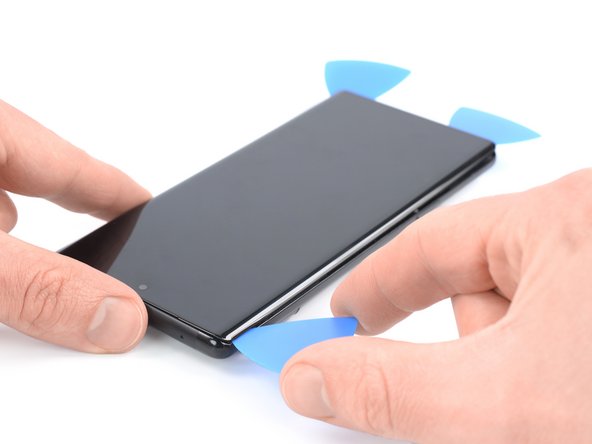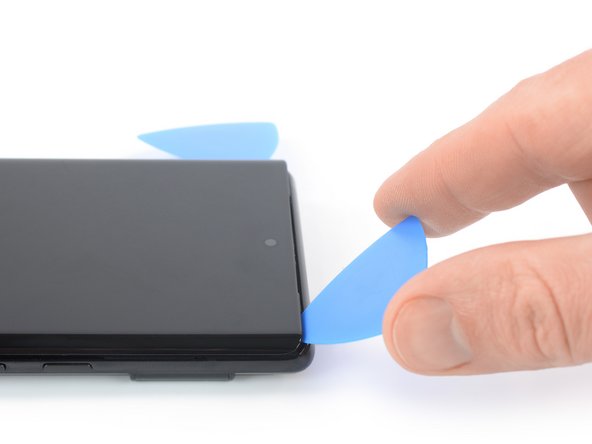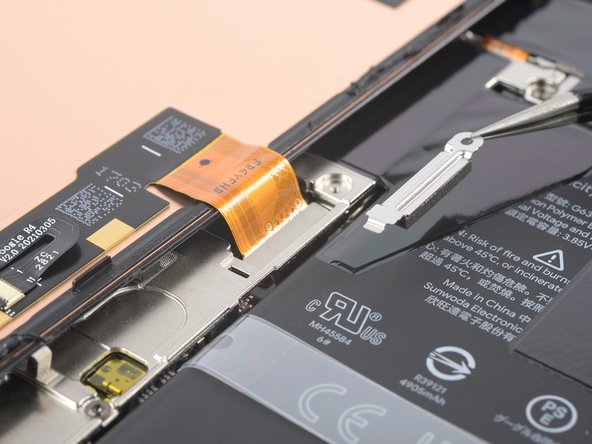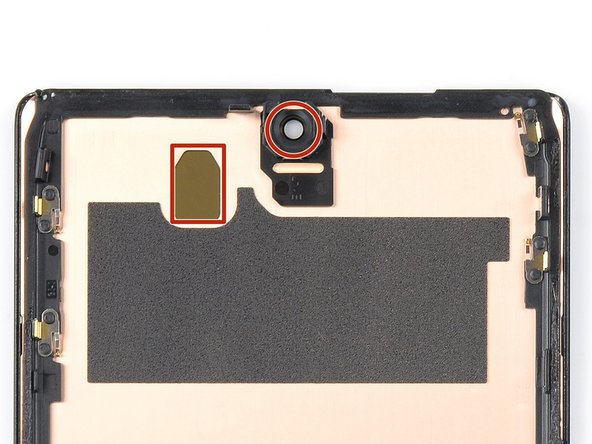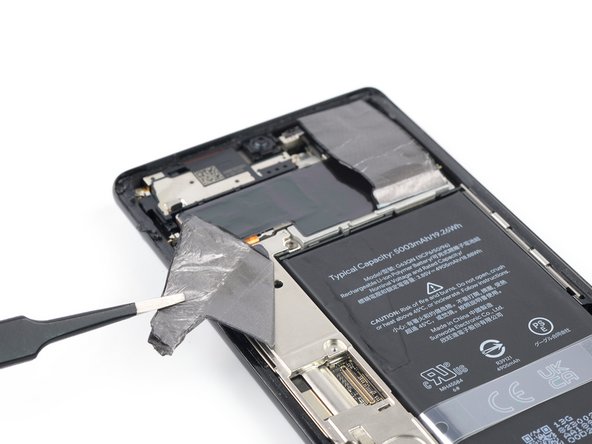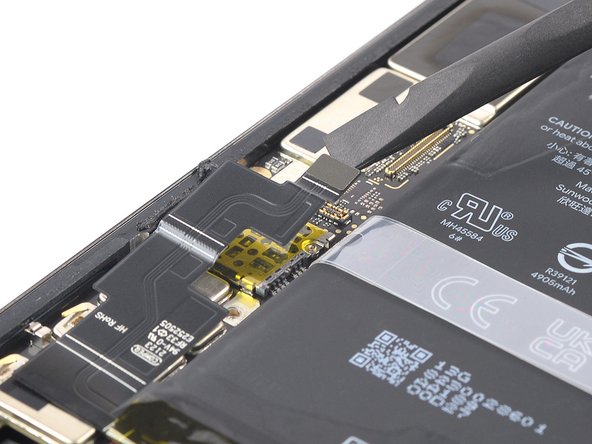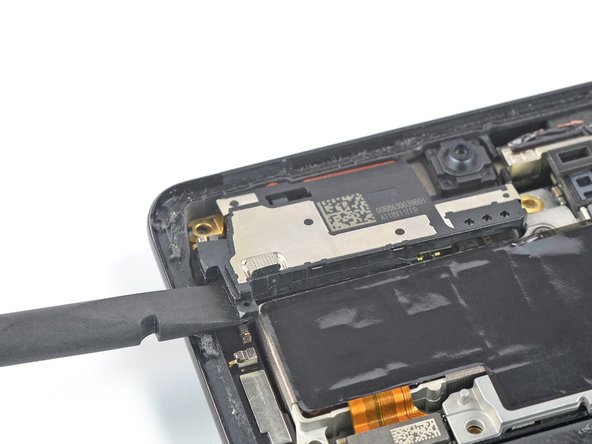Google Pixel 6 Pro Earpiece Speaker Replacement Guide
Duration: 45 minutes
Steps: 27 Steps
Hey there! Just a heads-up, this repair guide is brought to you by the awesome crew at Salvation Repair, and Google hasn’t given it a thumbs up. Want to learn more? Check out our repair guides here.
For your own well-being, make sure to drain that battery below 25% before you dive into the disassembly of your phone. Safety first, friends!
Get ready to breathe new life into your Google Pixel 6 Pro by replacing the earpiece speaker. Before you start, make sure to discharge your battery to below 25% to avoid any potential thermal issues. If your battery is swollen, take the necessary precautions to stay safe. Also, keep in mind that the Pixel 6 Pro contains class 1 lasers, so be careful when disassembling to avoid exposure to invisible infrared laser emissions. When you’re reassembling, remember that you’ll need some replacement adhesive to get everything stuck back together again. And don’t worry if you’re not feeling confident – if you need help, you can always schedule a repair. Follow this step-by-step guide to remove or replace the earpiece speaker in your Google Pixel 6 Pro. Salvation Repair’s team has put together this guide to help you get the job done. Remember to follow the steps carefully to ensure you retain as much water resistance as possible, but keep in mind that your device’s IP rating will be affected.
Step 1
Watch out, fam – let your battery go below 25% before trying out this fix. A charged battery could go boom if it’s damaged, so be careful and check out our repair services if you need a hand!
– Alright, let’s get this party started! First things first, give your phone a complete power down, like a disco ball after last call. Make sure any cables are unplugged. We’re ready to roll!
Step 2
Get ready to make the opening process a whole lot easier with our trusty Anti-Clamp tool! If you’re not using it, no worries – just skip ahead three steps for an alternative method.
Got a cracked screen? No problem! Just cover it with some clear packing tape to help your suction cup get a good grip.
Want the full lowdown on using the Anti-Clamp? Check out our guide for all the details.
If your phone’s surface is too slippery for the Anti-Clamp, don’t stress – just add some tape to give it a bit more traction. And if you need help along the way, you can always schedule a repair with the pros at Salvation Repair.
– Grab the blue handle and give it a nice pull backwards to unlock the Anti-Clamp’s arms.
– Slide those arms over either the left or right edge of your phone—your choice, buddy!
– Get those suction cups ready to party! Place them near the bottom edge of the phone—one on the front, and one on the back.
– Now squeeze those cups together to apply some serious suction. We’re talkin’ about holding onto that phone for dear life here.
Step 3
– Give the blue handle a gentle push forward, and watch those arms lock into place like magic.
– Twist that handle in a fun 360-degree spin (or just keep going until those cups start stretching out).
– Keep an eye on those suction cups and ensure they’re staying in sync. If they seem to be drifting apart, simply loosen them a bit and bring those arms back into harmony.
Step 4
Take it easy and don’t twist more than half a turn at once. Give it a minute between turns to let the Anti-Clamp do its thing. You’ve got this, just keep it chill!
Hey, you can also try using a hair dryer or heat gun, but be warned! Too much heat could cause some damage. So, be extra careful with that! And, if the Anti-Clamp isn’t opening up the gap you need, just add some more heat and turn the handle, but only a little bit more!
– Let’s get started! Heat up your iOpener and carefully thread it through the arms of the Anti-Clamp.
– Next, fold the iOpener so it’s snug against the bottom edge of your phone – this will help loosen things up.
– Now, take a minute to let the adhesive release its grip. You’ll start to see a gap open up, and that’s when the magic happens.
– When the Anti-Clamp creates a big enough gap, it’s time to bring in the opening pick. Slide it under the screen frame and you’re making progress!
– Go ahead and skip the next two steps – you’re doing great, and we’ll get back on track soon. If you need help, you can always schedule a repair.
Step 5
When it’s time to get your device nice and toasty, you can use a hair dryer, heat gun, or hot plate – just be sure to keep the heat in check so you don’t accidentally cook your gadget. If you need help, you can always schedule a repair
Step 6
Make sure your opening pick finds the sweet spot! Position it just right to keep the screen snug in its safety frame and away from the phone assembly. We want harmony, not chaos here!
If your screen is badly cracked, don’t worry – we’ve got you covered. Try slapping a layer of clear packing tape over it, and the suction handle should stick just fine. If that doesn’t work, you can use some seriously strong tape as a substitute. And if all else fails, a tiny bit of superglue can help the suction handle stick to the screen. If you need help, you can always schedule a repair
– Start by warming up that screen until it’s cozy to the touch. Now, grab a suction handle and stick it to the bottom edge of the screen.
– Give the screen a gentle lift using the suction handle, along with its safety frame, to create a tiny gap between the screen and the phone assembly.
– Time to insert an opening pick into that gap you’ve just made between the screen frame and the phone assembly.
– Slide your opening pick over to the bottom left corner of the screen to slice through the adhesive like a pro.
– Keep that opening pick in place to stop the adhesive from getting all clingy again.
Tools Used
Step 7
– Slide a second opening pick into the bottom edge and glide it over to the bottom right corner of the screen to help slice through that pesky adhesive.
– Keep the opening pick tucked in there to stop the adhesive from getting all clingy again.
Step 8
Hey there! The Google Pixel 6 Pro’s screen is held snugly in place not just by adhesive but also by some nifty little plastic pins. If your opening pick gets stuck while you’re trying to remove the screen, it probably means you’ve pushed it a bit too far underneath. Just remember to keep it simple—insert the tip of your opening pick only about 3-4 mm when cutting through that adhesive. You’ve got this!
– Let’s get this screen peeled up! Slide a third opening pick under the bottom left corner of the screen.
– Now, gently glide the opening pick along the left edge of the screen. Think of it like slicing through butter, but way cooler.
– Leave the opening pick chilling up there in the top left corner to make sure the glue doesn’t get all sticky again.
Step 9
When you’re getting close to the front-facing camera, just use the very tip of your opening pick (about 2-3 mm). You don’t want to scratch or smudge that camera lens, right? We want your selfies looking awesome! If you need help, you can always schedule a repair.
– Pop in a fourth opening pick at the top left corner of your screen—let’s get that party started!
– Gently slide that pick along the top edge of your device to cut through the adhesive like a pro.
– Keep that pick in the top right corner to make sure the adhesive doesn’t decide to play hide and seek.
Step 10
– Now, take your fifth opening pick and slide it along the right edge of the phone, like you’re giving the adhesive a high five, but with a pick. This will slice through any remaining adhesive, and we’re almost there! If you need help, you can always schedule a repair.
Step 12
A quick tip to get you started: the Pixel 6 Pro uses Torx Plus screws, but standard Torx bits will do the trick. Just remember to apply some steady, downward pressure to avoid stripping those screws.
As you work through this repair, keep track of each screw and make sure it ends up back where it belongs. If you need help, you can always schedule a repair
– Grab your trusty Torx T3 screwdriver and tackle that 2.0 mm-long 3IP Torx Plus screw that’s keeping your display cable metal bracket in place. You’ve got this!
Step 13
Don’t forget to hang on to this component for the grand reassembly finale!
– Alrighty, let’s get that metal bracket off the top of the display cable connector! You’re doing great so far. If you get stuck, remember, we’re here to help. Just shout out to our repair gurus at schedule a repair and they’ll get you back on track!
Tools Used
Step 14
– Let’s get this display flex cable out of its socket! Grab your trusty spudger and gently pry the connector straight up. You got this!
Tools Used
Step 15
Don’t forget to put that display cable bracket back where it belongs! It’s like putting the finishing touches on a masterpiece, so don’t skip it. 😉
– Start by gently removing the screen. Easy peasy!
– Now, as you get ready to put everything back together:
– If you swapped out the screen, take a moment to check the front-facing camera hole and the sensor cutout for any protective liners. Be sure to peel those off before you finish up your phone.
– Here’s a pro tip: test your phone before sealing it up! Plug in your screen, power on your phone, and see if it’s running smoothly. Once you’re satisfied, remember to power it off again and unplug the screen.
– If you’re jazzing it up with custom-cut adhesives, here’s the perfect guide for you.
– For those using a pre-cut adhesive card, this guide has your back.
– And if you’re fitting a shiny new screen, don’t forget to check out this guide to help calibrate the fingerprint sensor.
Step 16
Be careful not to apply heat directly to the battery, as it’s super sensitive to heat damage and could potentially cause a thermal event. If you’re not sure about this step, don’t worry – you can always schedule a repair and let the pros handle it.
Step 17
Be careful when handling the battery – if it gets punctured or bent, it could leak chemicals or overheat. If you’re not comfortable with this step, don’t worry, you can always schedule a repair
– Time to get up close and personal with your device’s internals. Use a pair of trusty blunt nose tweezers or a clean fingernail to gently pry the black graphite film off the bottom edge of the battery and the motherboard shield. Take your time, it’s a delicate process.
– Next, carefully remove the graphite film. If you’re not feeling confident, don’t worry – you can always schedule a repair with the experts at Salvation Repair.
Tools Used
Step 18
To swap out your battery, simply peel back the bottom part of the graphite film covering it. If you’re looking to replace your rear camera, you’ll need to remove the film completely. But if you only need to replace the earpiece speaker or front-facing camera, don’t worry about touching the film – you can leave it right where it is. If you need help, you can always schedule a repair
– Grab your trusty tweezers or a clean fingernail (we all have those, right?) and gently peel back that black graphite film from the top right corner of the battery. It’s like giving the battery a little high five!
– Now, fold that graphite film towards the selfie camera – think of it as giving the battery a little privacy. This will give you a clear view of the battery and make it easier to work with.
Tools Used
Step 19
If that graphite film is sticking harder than an overcooked marshmallow, it probably just needs a little warming up! Grab your iOpener or heat gun and give that back glass a gentle heat-up for about 1-2 minutes to soften things up again.
– Time to get those fingers working! Use a pair of blunt nose tweezers or a clean fingernail to carefully peel off the black graphite film from the left edge of the battery and the motherboard shield. If you need help, you can always schedule a repair
Step 20
– Grab your trusty Torx T3 screwdriver and gently unscrew those two 5.1 mm-long 3IP Torx Plus screws that are holding down the charging port metal bracket. You’ve got this!
Step 21
Don’t lose this little guy! You’ll need it when you put everything back together. 😉
– Let’s get that charging port bracket out! Grab your trusty tweezers and gently remove it. It’s like giving it a little high five, but with tweezers.
Tools Used
Step 22
– Grab your trusty Torx T3 screwdriver and get ready to tackle those five 5.1 mm-long 3IP Torx Plus screws holding the motherboard cover in place. You’ve got this!
Step 23
– Grab a trusty pair of tweezers or use your fingers to gently lift off that motherboard cover. You’ve got this!
Tools Used
Step 25
– Grab your trusty Torx T3 screwdriver and get ready! You’ll want to carefully remove the two 3.3 mm-long 3IP Torx Plus screws that are keeping the earpiece speaker snug as a bug. You’ve got this!
Step 26
– Slide a spudger right under the bottom left corner of the earpiece speaker, just like tucking in a cozy blanket.
– Now, give that spudger a gentle nudge to lift up the earpiece speaker by tilting it downwards. You’ve got this!
Tools Used
Step 27
– Grab a pair of tweezers or just use your fingers to gently lift out that earpiece speaker—easy does it!
– Now, take a moment to compare your shiny new replacement part with the original one. You might need to move some leftover components over or peel off any sticky backings from the new part before you get to installing it. You’ve got this!
Tools Used






















